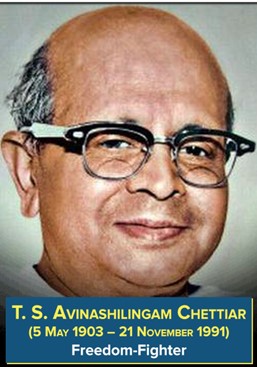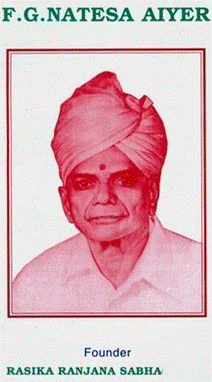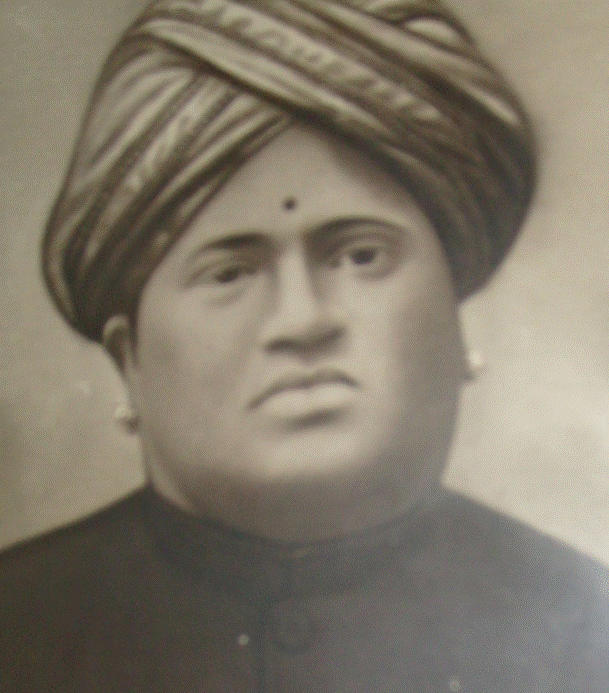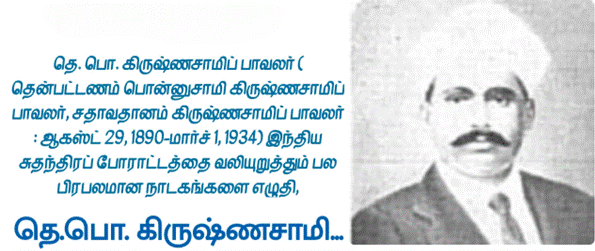PREVIOUS
Freedom Fighters from Tamil Nadu Part – 08
Freedom Fighters from Tamil Nadu Part – 08
(இதன் தமிழ் வடிவத்திற்கு இங்கே சொடுக்கவும்)
38. T. S. Avinashilingam Chettiar
Early Life and Education
- Date of Birth: May 5, 1903.
- Place of Birth: Tiruppur, Madras Presidency.
- Parents: K. Subrahmanya Chettiar.
Education:
- He did the high school in Tiruppur and Coimbatore.
- He graduated from Pachaiyappa's College, Madras, in 1923.
- He studied law at Madras Law College.
Involvement in the Indian Independence Movement
- Political Affiliation: Indian National Congress.
- Participation:
- He actively participated in the Civil Disobedience Movement and Quit India Movement.
- He adopted Gandhi’s philosophy and served as President of the Coimbatore District Congress Committee.
- Contributions:
- He assisted Mahatma Gandhi during his 1934 tour of South India for the Harijan Welfare Fund, collecting and donating ₹2.5 lakhs.
- Arrested four times during the freedom struggle (1930, 1932, 1941, and 1942).
Political Career:
- He was the Member of the Imperial Legislative Council from 1934 to 1945.
- He elected to the Madras Legislative Council in 1946.
Role as Minister of Education (Madras Presidency)
- Tenure: 1946-1949.
- Premier: Tanguturi Prakasam and O. P. Ramaswamy Reddiyar.
Key Contributions:
- He introduced Tamil as the medium of instruction in secondary schools across the Presidency
- He established the Tamil Valarchi Kalagam (Tamil Academy) in 1946, which created the first Tamil encyclopedia (published between 1954 and 1968).
- He nationalized the poetry of Subramania Bharati.
- He created a Professorship for Tamil and other Indian languages at the University of Madras.
- He introduced Thirukkural as part of the curriculum from the 6th grade onwards.
Later Political Career
- Lok Sabha: He represented Tiruppur from 1952 to 1957.
- Rajya Sabha: He served as a member from 1958 to 1964.
Social Reforms:
- He advocated for the upliftment of untouchables and widow remarriage.
- He established the Ramakrishna Vidyalaya school in Coimbatore, which admitted children of all castes.
Honors and Legacy
- Padma Bhushan: Awarded in 1970 for his contributions to education and literature.
Other Awards:
- G. D. Birla Award
- Jamnalal Bajaj Award (1985)
Institutions Established:
- He established institutions like Avinashilingam Home Science College for Women (1957), which became Avinashilingam University for Women in 1988.
Publications and Works
- He authored notable works on economics, Gandhi’s education policy, and the Wardha scheme.
- He wrote an account in Tamil about his pilgrimage to Tirukeedaram.
Death:
- November 21, 1991, at the age of 88.

39. F.G. Natesa Iyer
Early Life and Education
- Date of Birth: November 11, 1880
- Place of Birth: Pudukkotai, Tamil Nadu.
- Parents: Janaki ammaiyar and Gangadhara Shastri.
Career in the South Indian Railway
- Profession: Railway Officer.
- Achievements:
- He retired as the District Traffic Superintendent in 1935, the first Indian to hold this position.
Role in the Indian Independence Movement
- He joined the Indian National Congress in 1914.
- He represented as a delegate at various annual sessions of the Indian National Congress during World War I.
Key Congress Sessions:
- Bombay session (1915): He participated as a delegate.
- Lucknow session (1916): Member of the Subjects Committee.
- He participated in discussions on the Congress-Indian Muslim League’s scheme of reforms.
- Madras session (1917): He participated as delegate.
- He elected member of the All-India Congress Committee.
- He was the member of the Subjects Committee.
- He moved the resolution on indentured labour at the open session.
- He supported for Home Rule and Passive Resistance.
Indian Home Rule Movement:
- He supported the movement led by Annie Besant and others during the 1910s.
- He supported the resolution passed at the Madras Provincial Conference following the internment of Mrs. Annie Besant, George Arundale, and B. P. Wadia.
Contributions to Tamil Drama and Cinema
Pioneer:
- He was recognized as one of the pioneers of modern Tamil drama and cinema.
Death
- Date of Death: January 23, 1963.

40. S. A. Saminatha Iyer
Early Life and Education
- S. A. Saminatha Iyer, also known as Thanjavur Saminatha Iyer, was born in the Tanjore district of Tamil Nadu.
- He was son of Sankaranarayana Dikshitar.
- After completing his education, Saminatha Iyer began his career as a pleader in Nagapattinam and later moved to Tanjore around 1887, where he served as the Public Prosecutor at the Tanjore district court.
Political Involvement
- Entry into Politics: Saminatha Iyer became interested in politics during his practice in Nagapattinam.
- He was elected to the Nagapattinam municipality and served as a member in the early 1880s.
- Madras Native Association: In 1882, he played a key role in organizing the Madras Native Association branch in the district.
- Theosophical Society: In 1883, he established a branch of the Theosophical Society in Nagapattinam and served as its secretary.
- Involvement in Indian National Congress: In 1885, Saminatha Iyer moved to Kumbakonam and succeeded Sir A. Seshayya Sastri as President of the Tanjore People's Association.
- He was the sole delegate from the association to the first session of the Indian National Congress held in Bombay.
- Salt Tax Criticism: During the session, Saminatha Iyer vehemently criticized the Salt Tax, stating that increasing the tax would be unjust and would heavily burden the masses.
- Constitution of the Indian National Congress: In the 1887 session of the Indian National Congress held in Madras, Saminatha Iyer was appointed as a member of the 35-member committee that framed the constitution of the Indian National Congress.
- He also participated in the 1886, 1889, and 1894 sessions.
Civic Leadership
- Tanjore Municipality: Saminatha Iyer was elected to the District Board of Tanjore in 1886 and was nominated Chairman of the Tanjore Municipal Council in 1887.
- He presided over the golden jubilee celebrations of Queen Victoria's reign in Tanjore and was elected Secretary of the Rajah Mirasdar Hospital in Tanjore.
- Theosophical Society Leadership: In 1892, Saminatha Iyer became the President of the Tanjore branch of the Theosophical Society.
- Kumbakonam Temple Committee: He was elected to the Kumbakonam Temple Committee, which managed Hindu temples in the Kumbakonam division of Tanjore district.
- He remained a member of the committee from 1885 until his death.
Advocacy and Campaigns
- Land Revenue Agitation: In 1892, when the mirasidars of Thanjavur district agitated against the rise in land revenue, Saminatha Iyer led the movement.
- Christian Missionary Schools Controversy: Saminatha Iyer was involved in agitations against Christian missionary schools, advocating for the establishment of national schools and criticizing the lavish spending of missionaries.
Death
- S. A. Saminatha Iyer passed away on 12 August 1899.

41. T. P. Krishnasamy Pavalar
Birth and Early Life
- T. P. Krishnasamy Pavalar was born on August 29, 1890, in Chintadripet, Chennai.
- He was the elder brother of the renowned Tamil scholar T. P. Meenakshi sundaranar.
Career and Contribution to Freedom Movement
- Pavalar served as the head Tamil teacher at Muthialpet School.
- However, in 1917, after the arrest of Annie Besant, he resigned from his teaching position to join the Indian National Congress and actively participate in the freedom struggle.
Literary Genius
- Pavalar was known for his extraordinary talent in Tamil literature.
- His ability to compose poetry spontaneously earned him the nickname "Asukavi" from Pammal Sambandha Mudaliar.
- He utilized drama as a powerful tool to inspire and mobilize people against British rule, at a time when theatre was a dominant medium of expression.
Dramas
- One of his significant plays, "Kadharin Vettri" (The Victory of Khadar), was staged in 1922, symbolizing the Khadi movement.
- Although the British government banned the play, Pavalar ingeniously renamed it "Kadhar Bhakthi" and continued to stage it, thereby reigniting the spirit of the freedom struggle.
- He also staged this play in London, exposing the atrocities of British rule to the English audience.
- In 1923, Pavalar wrote the play "Desiya Kodi" (The National Flag), based on the flag protest in Nagpur.
- This play spread the message of protecting the national flag throughout Tamil Nadu.
Other Notable Works
- His play "Bombay Mail" featured scenes with the unfurling of the tricolor Khadi flag, which evoked deep patriotic sentiments among the audience.
- Pavalar’s plays were known for their emotional intensity and nationalist fervor.
Journalism and Literary Contributions
- Pavalar was also a prolific journalist, running journals like "Desabandhu," "Bharathi," and "Indraya Samacharam."
Multifaceted Talent
- A versatile genius, Pavalar was also a "Sathavadhani," a person capable of performing a hundred different mental tasks simultaneously.
- He dedicated all his talents to the cause of India's freedom struggle.
Demise
- T. P. Krishnasamy Pavalar passed away on March 1, 1934.



